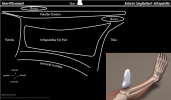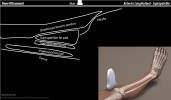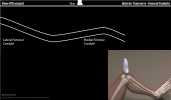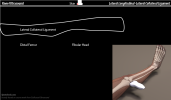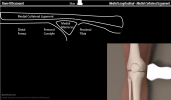Knee Ultrasound
- Indications
- Dynamic tendon evaluation (e.g. Patellar tendon, quadriceps tendon)
- Collateral ligament evaluation
- Baker Cyst
- Neurovascular evaluation
- Knee Effusion evaluation (esp. to direct needle aspiration)
- Technique
- Anterior Knee Ultrasound
- Positioning
- Patient lies supine with knee flexed 20 degrees over towel roll
- View 1: Long Axis (LAX) with indicator towards proximal leg (hip)
- Superior aspect (suprapatellar)
- Inferior aspect (infrapatellar)
- View 2: Short Axis (SAX)
- Start at distal thigh (where each of four quad Muscles are visible)
- Slide probe inferiorly down the anterior knee
- Quadriceps tendon
- Suprapatellar bursa (to either side of tendon)
- Patella
- Femoral trochlear cartilage (with hyaline cartilage)
- Appears as two parallel lines
- Best evaluated with knee in 90 degree flexion with suprapatellar approach directed under Patella
- Infrapatellar bursa (to either side of tendon)
- Patellar tendon
- Images
- Clinical indications
- Directs Knee Aspiration by identifying largest fluid pocket and guiding needle entry
- Technique
- Medial Knee Ultrasound
- Positioning
- Patient lies supine with knee flexed 20 degrees over towel rolll (as with anterior Knee Exam)
- Leg external rotation improves access to medial compartment
- Images
- Components
- Superficial structures
- Medial collateral ligament
- Medial patellofemoral ligament (MPFL)
- Tears with Patellar Dislocation
- Pes anserine bursa
- Difficult to visualize
- Lies immediately superficial to medial collateral ligament at distal aspect
- Mid-structures
- Medial meniscus
- Suboptimal evaluation (poor sensitivity for pathology compared with gold standard MRI)
- Peripheral meniscal tear may be visualized
- Medial meniscus
- Deep structures
- Distal femur and medial femoral condyle
- Proximal tubia
- Superficial structures
- Technique
- Lateral Knee Ultrasound
- Positioning
- Patient lies supine with knee flexed 20-30 degrees over towel roll (as with anterior Knee Exam)
- Start with probe in long axis (LAX) anteriorly over the Patellar tendon in the infrapatellar region (as above)
- Slide the probe laterally observing the femur margin as it elongates over the length of the screen
- Images
- Anatomy ("Z" of the ITB, LCL and Biceps Femoris)
- Ultrasound
- Approach
- IT Band, lateral collateral ligament and Biceps Femoris form a "Z"
- Start in-line with the IT Band at the anterolateral knee
- Keep probe fixed at the proximal end and pivot the distal end to overly the lateral collateral ligament
- Keep probe fixed at the distal end and pivot the proximal end to overly the biceps femoris
- Components
- Iliotibial Band (IT Band)
- Anterior (inserts at tibia)
- Lateral collateral ligament
- Lies posterior to IT Band
- Slide probe posteriorly until femur develops popliteal notch (with popliteal tendon)
- Slide probe inferiorly down distal femur over the joint space to visualize the fibular head
- Lateral collateral ligament (LCL) will be immediately overlying the joint space (femur-fibula)
- LCL inserts at fibula (shares fibular insertion with biceps femoris)
- Lies posterior to IT Band
- Biceps femoris
- Inserts at fibula (shares fibular insertion with IT Band)
- Lateral Meniscus
- Suboptimal evaluation (poor sensitivity for pathology compared with gold standard MRI)
- Peripheral meniscal tear may be visualized
- Iliotibial Band (IT Band)
- Technique
- Posterior Knee Ultrasound
- Positioning
- Patient lies prone with foot propped on pillow
- Ultrasound probe in short axis (SAX) with indicator directed medially
- Components
- Baker's Cyst
- Between semitendinosis, semimembranosus (medial) and medial gastrocnemius
- Posterior Collateral Ligament
- Typically non-diagnostic views as does not visualize tibial insertion
- Peroneal nerve
- Nerurovascular bundle (popliteal vein, popliteal artery)
- Baker's Cyst
- References
- Mazzola (2016) GCUS Musculoskeletal Ultrasound Course, St. Pete's Beach, FL
- Moore (2013) Lower Extremity Ultrasound Video, Gulf Coast Ultrasound
